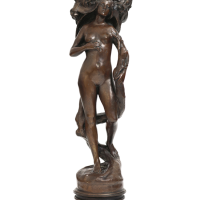12. BERTRAM MACKENNAL

Lithe, sinuous and graceful, Daphne, 1897, is the successful realisation of Bertram Mackennals aim to create sculpture that merged figurative elements with the suggestion of an immateriality beyond this world. Produced and exhibited in the same year, at Londons Royal Academy, Daphne capitalised on the world-wide success enjoyed by his life-size sculpture Circe, 1893, and was especially attractive to a burgeoning circle of European patrons who were intent on collecting domestically and commercially scaled sculptural forms and statuettes for their own homes.
The subject of Daphne and Apollo is a popular one in Western art and literature. It has been made famous by numerous visual artists, notably Gian Lorenzo Bernini, in his impressive life-sized Baroque marble sculpture executed between 1622 and 1625 and housed in the Villa Borghese, Rome. Like many of his compatriots, Bernini focuses on the climax of the story when the two central protagonists entwine and become one.
In a beautifully written account contained in Book 1 of Metamorphoses, the classical Roman poet Ovid describes how the love-struck Phoebus (Apollo) is spurned by the beautiful maiden Daphne who in turn flees from his grasp. When her strength is almost spent Daphne pleads to her father, Peneus, for help. Peneus responds by forsaking her physical beauty and turning her into a tree. Witnessing the transformation, Apollo is undeterred and declares his unrequited love: But since you canst not be my spouse surely thou shalt be my tree.1
In Daphne, Mackennal captures the moment of metamorphosis by focusing on a moment of internal bliss or jouissance. Daphne writhes and twists in an erotic swoon but, unlike traditional depictions such as that of Berninis, the emphasis is on her transformation through an internal delight. The upward tilt of the head, the half-closed eyes and the placement of her right arm suggest a metamorphosis from the physical to the psychological realm. It is as if Daphne is caught in a trance-like state that leads ultimately to a moment of intense self-realisation. The corresponding sexual tension is aided by the use of arabesque line and her body is fused with the metaphysical rhythms of nature. The delicate burnishing of the surface casts light and shadow that combines in the most evocative of ways.
Daphne has been described as Mackennal's finest example of Art Nouveau sculpture and an example of the New Sculpture movement that sought to foster new ways of experiencing modern sculpture. As noted in the relevant entry for this work in the Art Gallery of New South Wales: The New Sculptors displaced the traditional small scale antique copy with modern figures of imaginative contemplation. This program became the impetus for Mackennal's most evocative Academy sculptures, particularly Daphne, which is one of the artist's most unconventional compositions and compelling female figures. Mackennal had here followed British sculptor Alfred Gilbert's model in combining richly textured Art-Nouveau influenced organic forms with neo-Florentine statuette traditions in order to create a figure of self-involved intensity and covert eroticism that is one of the artist's most successful of this period.2
Visitors to Mackennals studio in St Johns Wood, London, to see his works, including Daphne, prior to them going to the Royal Academy, were under no illusion as to the aesthetic significance of the work. People who lived in Victoria, the correspondent suggested, should take special pride in Mackennals achievements noting: on the day he was visited by a large number of Australians who were very pleased with the admirable work being done by their countryman and the high position he holds among contemporary sculptors.3
Footnotes:
1. Ovid, Metamorphoses, Bk I:553-567. There are various interpretations of this passage including Since you cannot be my bride, you must be my tree!
2. Daphne, Art Gallery of New South Wales, http://www.artgallery.nsw.gov.au/collection/works/98.2014/
3. London correspondent, Australian artists: Works accepted by the Royal Academy, The Argus, 7 May 1897, p.5.
Rodney James BA (Hons); MA